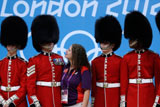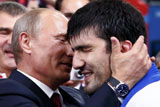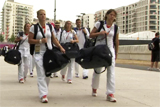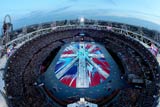Modern Pentathlon
Updated: 2012-05-16 10:15:52
( london2012.com)
|
|||||||||||
At the London 2012 Games Modern Pentathlon celebrates 100 years as part of the Olympic Games.
Modern Pentathlon was championed by Baron Pierre de Coubertin, the founder of the modern Olympic Games, and has its origins in a 19th-century legend.
The story goes that a young French cavalry officer was sent on horseback to deliver a message. To complete his mission, he had to ride, fence, shoot, swim and run - the five challenges that face competitors in Modern Pentathlon today.
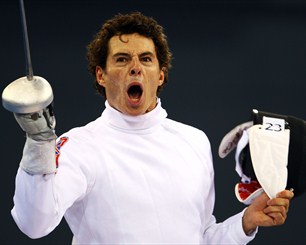
Competition dates:
Aug 11 - 12
Competition venue:
Copper Box - fencing
Aquatics Center - swimming
Greenwich Park - riding, combined event
Number of medal events
Two - men's and women's competition.
Number of competitors
72 (36 men and 36 women). Each country is limited to four athletes (two men and two women).
Field of play
Athletes fence in the Copper Box; compete in a 200m freestyle race in the pool in the Aquatics Centre; ride a 350-400m show jumping course in Greenwich Park; and finish with a 3km run, which includes shooting points, also in Greenwich Park.
History of Modern Pentathlon at the Olympic Games
Modern Pentathlon first appeared at the Stockholm 1912 Olympic Games, with the women's competition making its debut at Sydney 2000.
The basics
Modern Pentathlon competitions are staged over a single day. The first element is fencing, in which athletes are required to fence against every other athlete. The fencing is followed by swimming (200m freestyle) and riding (jumping over a 12-jump course). Athletes are given a score for each element of the competition.
After the first three elements, the athletes' total scores are converted into a time handicap. The handicap determines the starting times for the combined event, in which athletes are required to shoot five targets within 70 seconds (three times) and run 1,000m (three times). The winner of the competition is the athlete who crosses the finish line first.
Competition format
Fencing - Athletes compete against all others, using the epée. The first athlete to score a hit wins the bout. If neither scores within one minute, both athletes register a defeat. An athlete scores 1,000 points for winning 70 per cent of his/her bouts. Each win above or below the 70 per cent mark scores +/- 24 points.
Swimming - Athletes are seeded into heats dependent on their personal best times over the previous 12 months. A time of 2:30 for the 200m freestyle race scores 1,000 points. Each 0.33 seconds above or below this time scores +/- four points.
Riding - Athletes start with 1,200 points. They lose 20 points for each jump they knock down, 40 points for a refusal to jump or disobedience, and 60 points for a fall. They lose four points for each second they are over the allotted time (which is determined by the course size). If an athlete takes twice the allowed time, his/her participation in the event is terminated.
Combined event - The athlete with the most points from the previous events starts first. Athletes after that start in order at handicapped time intervals of one second for every four points. They must run to the shooting range, hit five targets in a 70s time period, followed by a 1,000m run; three times over.
The first athlete to cross the finish line in the combined event is the winner of the gold medal.
Officials
Such a complex sport requires many different officials, who preside over the individual events as they would in the sports themselves. A competition jury oversees each event; they have the power to disqualify athletes for serious infringements of the rules.
Keys to success
Modern pentathletes are all-rounders. A good performance in the first three events is the perfect set up for a strong finish, but with a staggered start to the run/shoot, an athlete who is exceptionally strong in this event can come from down the field to take gold.
Breaking the rules
Consistent performance is important, but an athlete who has done well in the fencing, the swimming and the riding can still be beaten on the run if they don’t have the strength and stamina to stay ahead.
Jargon buster
Epée - A thrusting sword, the épée is used in the fencing element of Modern Pentathlon competitions.
Freestyle - The swimming element is a freestyle race, which in effect means that all athletes favour the front crawl, as it is the fastest stroke.
Handicap start - In the combined event, the event leader starts first and the other athletes begin afterwards in competition order, with the start times dependent on the results of the previous three events.
Medal Count |
||||
| 1 | 46 | 29 | 29 | |
| 2 | 38 | 27 | 22 | |
| 3 | 29 | 17 | 19 | |
| 4 | 24 | 25 | 33 | |
| 5 | 13 | 8 | 7 | |
| 6 | 11 | 19 | 14 | |


